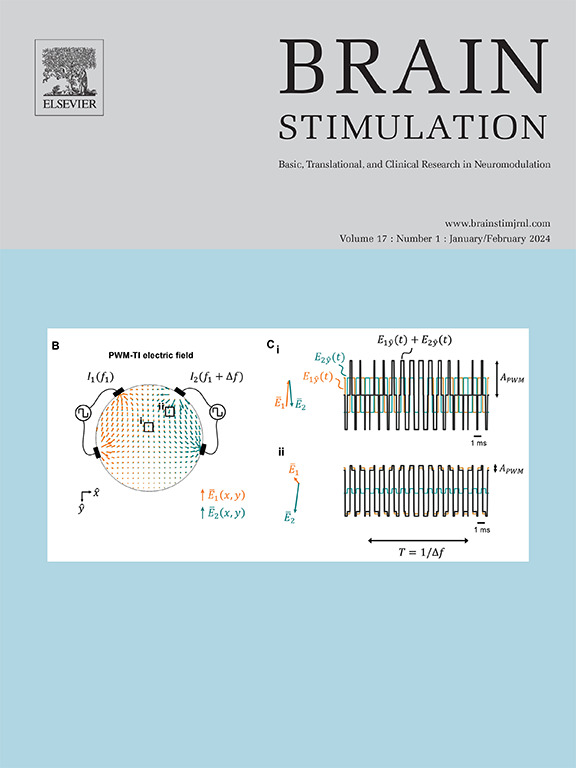从丘脑下局部场电位到帕金森病慢性脑深部刺激接触点的选择——系统综述。
IF 8.4
1区 医学
Q1 CLINICAL NEUROLOGY
引用次数: 0
摘要
背景:为帕金森病(PD)的最佳症状控制而规划丘脑下核深部脑刺激(DBS)需要时间和训练有素的人员。新型植入式神经刺激器允许记录局部场电位(LFP),可用于识别最佳(慢性)刺激接触。然而,文献对LFP的哪些特征和预测技术最有效尚无定论。目的:评价不同lfp生理指标在预测最佳(慢性)刺激接触中的作用。方法:对9个数据库进行文献检索,共纳入418篇论文。两位独立审稿人根据标题、摘要和全文对文章进行筛选。纳入研究的质量使用修改后的乔安娜布里格斯研究所病例系列关键评估清单进行评估。根据先验机会的预测性能,将结果分为四类。结果:纳入25项研究。单一特征的β波段预测在94%的结果中显示出积极的表现得分。基于单一非-频率特征的预测仅在25%的结果中获得正分数,主要是高频振荡的正结果。多特征预测(例如机器学习)在两个最高性能类别中获得准确率分数的频率高于基于单一beta的预测(100% vs 39%)。结论:基于LFP记录预测最佳刺激接触是可行的,可提高PD患者DBS规划效率。单个β波段预测比单独的非β频率特征显示出更有希望的结果,但多特征预测的表现要好。未来的研究应进一步探索多特征预测的最佳接触识别。本文章由计算机程序翻译,如有差异,请以英文原文为准。
From subthalamic local field potentials to the selection of chronic deep brain stimulation contacts in Parkinson's disease - A systematic review
Background
Programming deep brain stimulation (DBS) of the subthalamic nucleus for optimal symptom control in Parkinson's Disease (PD) requires time and trained personnel. Novel implantable neurostimulators allow local field potentials (LFP) recording, which could be used to identify the optimal (chronic) stimulation contact. However, literature is inconclusive on which LFP features and prediction techniques are most effective.
Objective
To evaluate the performance of different LFP-based physiomarkers for predicting the optimal (chronic) stimulation contacts.
Methods
A literature search was conducted across nine databases, resulting in 418 individual papers. Two independent reviewers screened the articles based on title, abstract, and full text. The quality of included studies was assessed using a modified Joanna Briggs Institute Critical Appraisal Checklist for Case Series. Results were categorised in four classes based on the predictive performance with respect to the a priori chance.
Results
Twenty-five studies were included. Single-feature beta-band predictions demonstrated positive performance scores in 94 % of the outcomes. Predictions based on single non-beta-frequency features yielded positive scores in only 25 % of the outcomes, with positive results mainly for high frequency oscillations. Multi-feature predictions (e.g. machine learning) achieved accuracy scores within the two highest performance classes more often than single beta-based predictions (100 % versus 39 %).
Conclusion
Predicting the optimal stimulation contact based on LFP recordings is feasible and can improve DBS programming efficiency in PD. Single beta-band predictions show more promising results than non-beta-frequency features alone, but are outperformed by multi-feature predictions. Future research should further explore multi-feature predictions for optimal contact identification.
求助全文
通过发布文献求助,成功后即可免费获取论文全文。
去求助
来源期刊

Brain Stimulation
医学-临床神经学
CiteScore
13.10
自引率
9.10%
发文量
256
审稿时长
72 days
期刊介绍:
Brain Stimulation publishes on the entire field of brain stimulation, including noninvasive and invasive techniques and technologies that alter brain function through the use of electrical, magnetic, radiowave, or focally targeted pharmacologic stimulation.
Brain Stimulation aims to be the premier journal for publication of original research in the field of neuromodulation. The journal includes: a) Original articles; b) Short Communications; c) Invited and original reviews; d) Technology and methodological perspectives (reviews of new devices, description of new methods, etc.); and e) Letters to the Editor. Special issues of the journal will be considered based on scientific merit.
 求助内容:
求助内容: 应助结果提醒方式:
应助结果提醒方式:


